Chapter 11 - Further Matrices
1/17
Earn XP
Description and Tags
Following up from Ch 10 - in a nutshell (of course, literally)
Name | Mastery | Learn | Test | Matching | Spaced |
|---|
No study sessions yet.
18 Terms
Transition Matrix
Represents how states change from one to another over time
Square matrix with proportions (decimals), showing percentage chances
Used in systems like weather prediction or state transitions
Visualized as a directed graph: vertices = states, edges = transition probabilities
Columns = Starting states (where you begin)
Rows = Ending states (where you end up)
Each column sums to 1 (100% of probability spreads out)
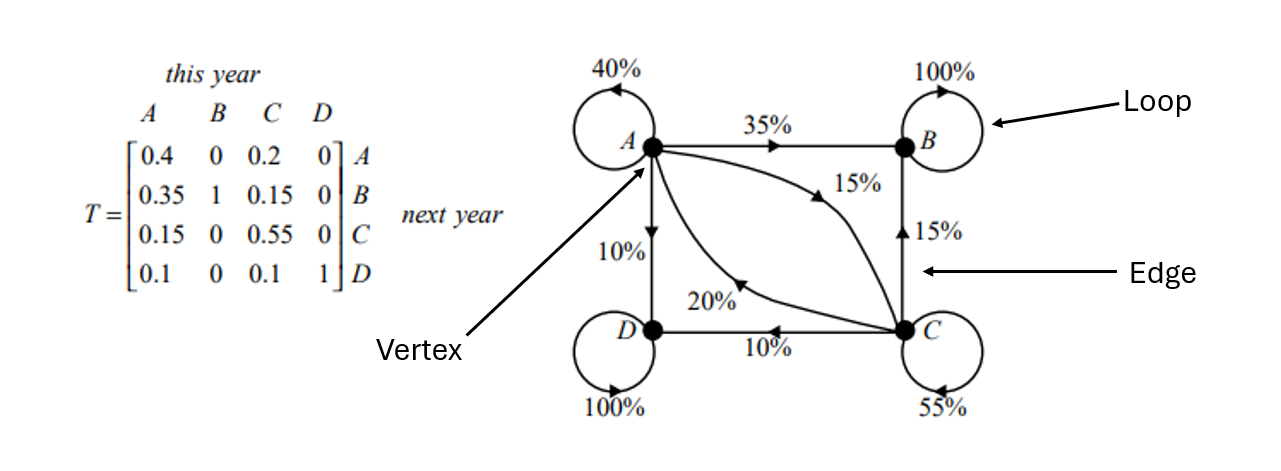
Interpretation of Transition Matrix: Example
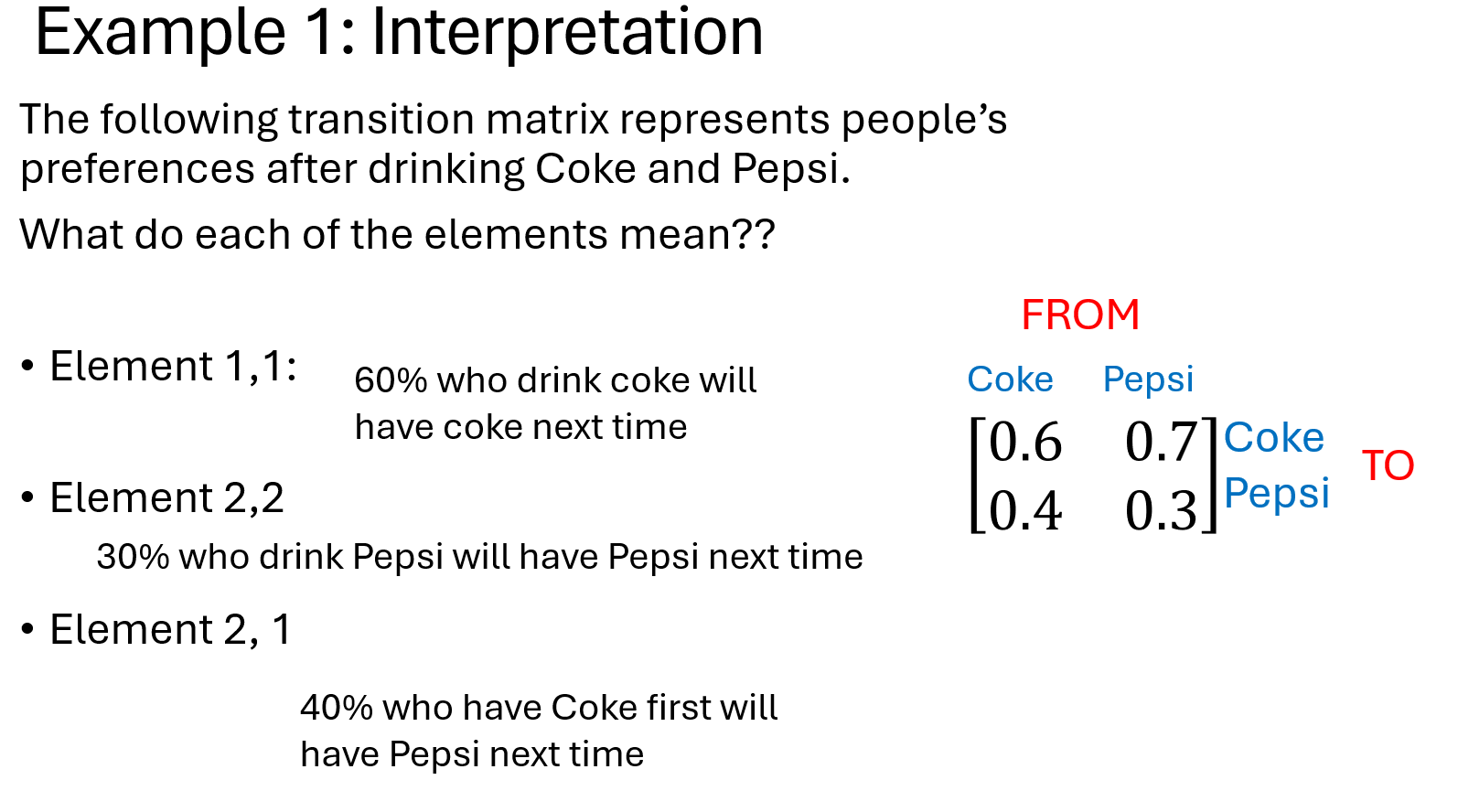
State Matrix
Transition matrix = proportions moving between states
State matrix = counts/items in each state at a time (column matrix)
Initial state matrix (S₀) = starting counts
Example:
S₀ = [50 40] for Bendigo (B) and Colac (C)Labels match those in the transition matrix for clarity
Be Careful with State Matrix!
Initial state matrix varies by question — always check what time it represents (start, after 1 week, etc.)
Identify the correct starting point before applying transitions
Time changes = multiply by transition matrix the right number of times (e.g., S₁ = Transition × S₀, S₂ = Transition² × S₀)
Don’t assume initial = time zero unless stated!
Transitions and State Matrices
To find next state: Sₙ₊₁ = T × Sₙ
Start with S₀ (initial state)
Multiply by T (transition matrix) to get state after 1 step (S₁)
Repeat for continuous steps:
S₂ = T × S₁
S₃ = T × S₂, and so on...
Pre-multiply every time (transition matrix goes before state matrix)
Each multiplication redistributes objects according to transition probabilities
Rule for Finding the State Matrix
n = number of time periods (days, months, years, etc.)
To find state after n steps:
Sₙ = Tⁿ × S₀
Raise the transition matrix T to the power n (use CAS or by repeated multiplication)
Multiply by the initial state matrix S₀
Result: state distribution after n transitions
Steady State Matrix
The point where objects keep moving but overall numbers at each point don’t change
Happens when leaving = arriving at every point
Requires:
Regular transition matrix (powers have no zero elements)
Columns sum to 1
Found by letting n → ∞ in 𝑆ₙ = 𝑇ⁿ𝑆₀
Tip: let n be a large number but not too much and check by raise the power with diff one e.g., 99 and 100
Finding Steady State Using Ratios (2×2 Matrices Only)
Used when steady state is known but transition matrix is unknown
Set the steady state proportions as variables (e.g., x and y)
Use the fact that in steady state, inflow = outflow for each state
Write equations based on transition probabilities as ratios between x and y
Solve for the ratio x : y to find steady state distribution
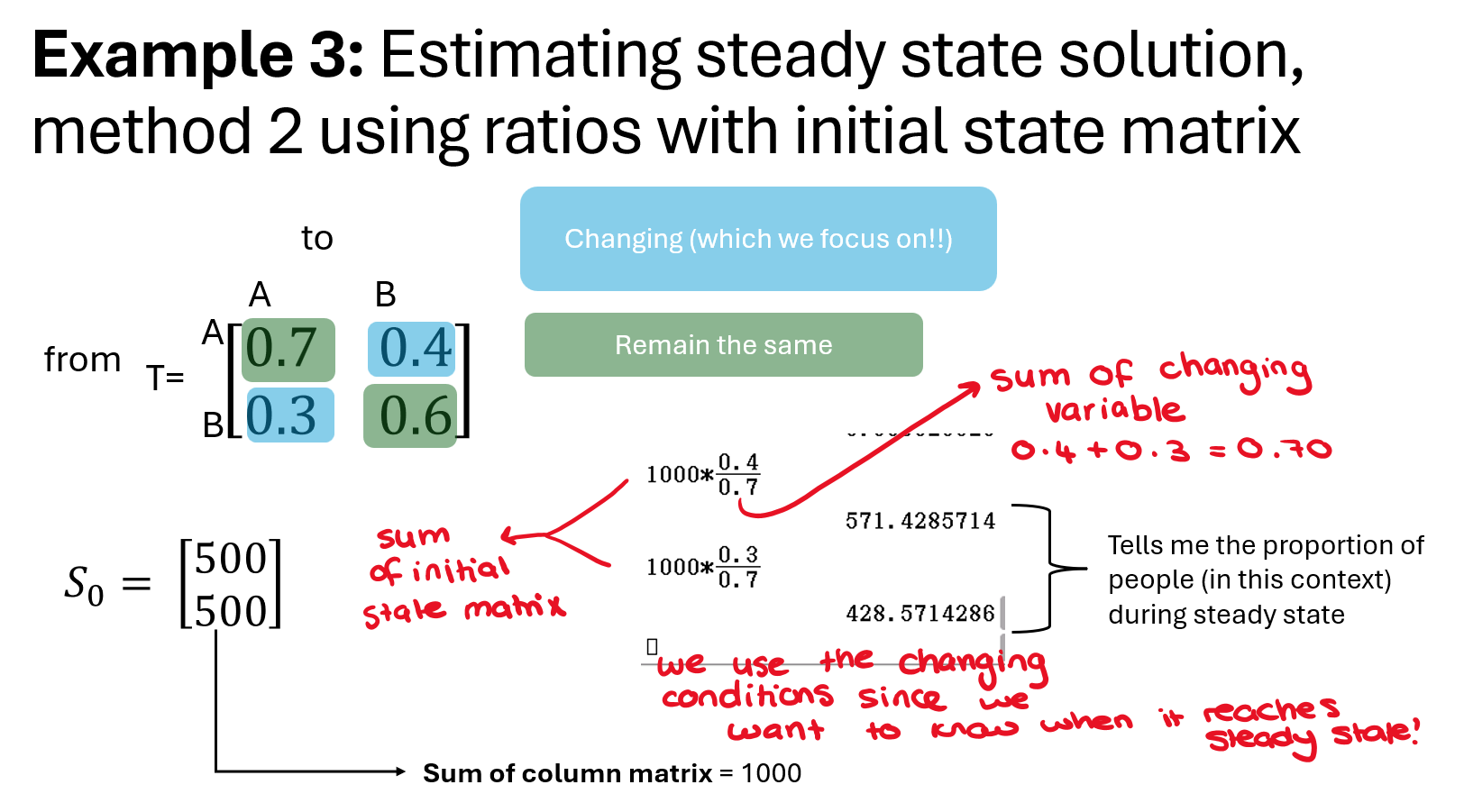
Changing Values in Recurrence Relation
Normal rule:
S₀ = initial state
Sₙ₊₁ = T × Sₙ (population constant)When population changes by fixed amount:
Sₙ₊₁ = T × Sₙ ± B
B = column matrix with fixed additions/subtractionsCulling:
Taking away items → B is negativeRestocking:
Adding items → B is positiveRearranged equation:
Sn = T⁻¹ (Sn+1 − B) → Make sure that this is in brackets and DO NOT do it step-by-step basis
General: Culling / Restocking

Leslie Matrices (L)
Special transition matrix modelling population changes over time (ignores migration).
Focuses on females only (birth givers).
Population split into equal-length age groups covering lifespan.
Key factors for each age group iii:
Birth rate bi: average number of female offspring per mother in age group iii per time period.
Survival rate si: proportion of females in age group iii who survive to age group i+1 (Note 0≤si≤1).
Leslie matrix tracks birth + survival across age groups.
Leslie Matrix Quick Guide
First row: Birth rates (fecundities) — average female offspring per age group, can be >1 or 0 if no births. ONLY ROW REQUIRED TO HAVE ON AVERAGE WHEN ANALYSING!!!
Subsequent rows: Survival rates — proportion moving from one age group to the next (0 to 1). DO NOT INCLUDE ON AVERAGE WHEN ANALYSING!!!!!
Last row: Survival of oldest group, either 0 or feeding back into itself if they survive another period.
Key: Births at top, survival flows down.
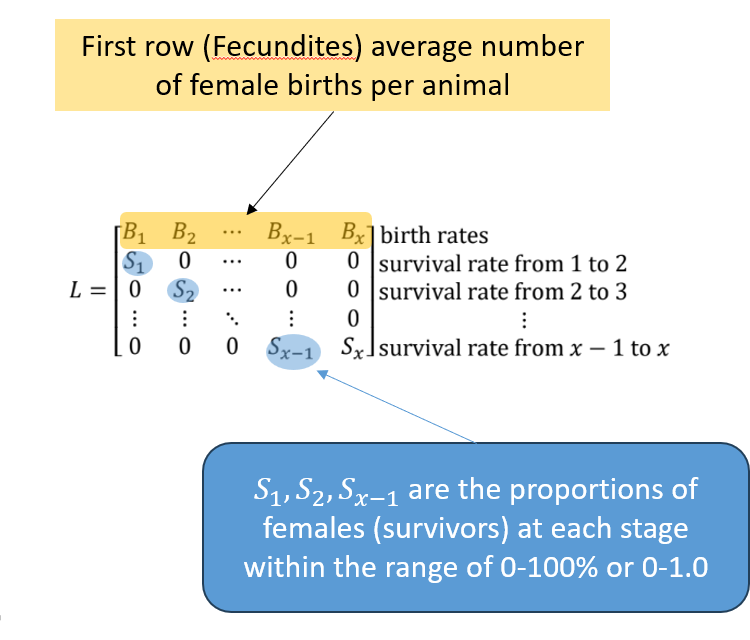
Interpreting Leslie Matrices: Dung Beetle Example
Age groups: Juvenile (J), Adult (A), Senior (S)
First row (Fecundity): Average offspring per age group — controls next Juvenile population size
l₁,₁: Juveniles = 0 (too young to reproduce)
l₁,₂: Adults = 2 juveniles each
l₁,₃: Seniors = 1.5 juveniles each
Into Adults (Row 2): Transitions into Adults
l₂,₁: 40% of Juveniles become Adults
l₂,₂: 0% Adults remain Adults
l₂,₃: 0% Seniors become Adults (no backward aging)
Into Seniors (Row 3): Transitions into Seniors
l₃,₁: 0% Juveniles become Seniors (no skipping stages)
l₃,₂: 35% Adults become Seniors
l₃,₃: 0% Seniors remain Seniors (no staying unless specified)
Key points:
High fecundity → fast growth, good replacement, less extinction risk
Low fecundity → slow recovery, risk of decline or extinction
Fecundity row is the heartbeat of survival — it shapes the future population flow.
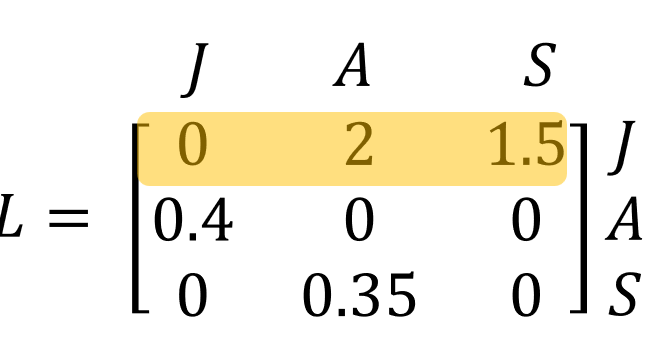
Leslie Matrix Life Cycle Diagram
Horizontal arrows: Show the proportion of each age group that progresses to the next stage.
Back arrows to first age group: Represent the number of offspring produced by each age group.
If on 1,1: then a circle on the diagram to itself

Recurrence Relation / Rule for leslie state matrix
Recurrence Relation (step-by-step movement):
S₀ = initial value, Sₙ₊₁ = L × Sₙ
Rule for finding the state matrix:
Sₙ = Lⁿ × S₀
Same steps as with transition matrices — just swap in the Leslie matrix (L).
Population State Matrix
A column matrix showing the number of individuals in each age group at a given time.
The initial state matrix is S₀.
Example: If there are 400 females in each age group at the start:
S₀ = [400400
400]
Each step forward uses: Sₙ₊₁ = L × Sₙ.
![<p>A <strong>column matrix</strong> showing the number of individuals in each <strong>age group</strong> at a given time.</p><ul><li><p>The <strong>initial</strong> state matrix is <strong>S₀</strong>.</p></li><li><p>Example: If there are 400 females in <strong>each</strong> age group at the start:<br> S₀ = [400</p><p> 400</p><p> 400]</p></li></ul><p>Each step forward uses: <strong>Sₙ₊₁ = L × Sₙ</strong>.</p>](https://knowt-user-attachments.s3.amazonaws.com/ee1e14b2-7403-4e6f-b37d-dc64ce928600.png)
Long-Term Trends with Leslie Matrices (m × m)
Increasing population → if Sₘ > S₀
Decreasing population → if Sₘ < S₀
Cycling/oscillating population → if Sₘ = S₀, repeats every m steps
➡ Happens when: Lᵐ = I (identity matrix)
Check Sₘ after m time periods to detect trend.
Growth Rates (Limiting Behaviour) – Leslie Matrices
Populations don’t reach steady state, but reach proportional equilibrium
Proportions in each age group stabilise, even if total numbers change
This is called the long-term growth rate, denoted by g
Rule:
If for all elements:
Sₙ₊₁ / Sₙ = same value = g
Then:
g > 1 → Population increases
g < 1 → Population decreases
g = 1 → Population is stable
Formula:
L × Sₙ = g × Sₙ₋₁
g = growth rate of the population each time period
To find % growth: (g − 1) × 100%
g must be a real number